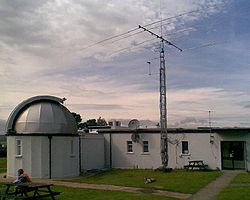- Lockyer Observatory and Planetarium
-
Coordinates: 50°41′06″N 3°13′12″W / 50.685°N 3.220°W
The Norman Lockyer Observatory and Planetarium (NLO) is a planetarium and a public access optical observatory in East Devon on the Jurassic Coast of South West England.[1]
Contents
Location and instruments
The Norman Lockyer Observatory and Planetarium is situated near a south facing cliff one mile east of the coastal town of Sidmouth, fifteen miles southeast of Exeter and ten miles from the M5 motorway. The observatory provides modern telescopes with computer enhanced imaging, as well as maintaining some of the nation's most historic instruments, and enjoys a relatively dark night sky with a southerly aspect across the sea. There are four domes; McClean (12" refractor), Kensington (10" refractor), Victoria, (12" reflector) and Mond which houses the famous 6¼-inch Lockyer telescope which the astronomer Norman Lockyer used to discover helium during the solar eclipse of 1868.
The observatory is particularly well situated for spectral analysis in astronomy, which requires a clear sky over the whole optical spectrum, as it enjoys a relatively "clean" sky to the east and south across the sea. The atmosphere is usually free of air pollution and light pollution and, as the sea has a uniform temperature, the air is also free of rising currents which can distort optical images.
The observatory is active in both optical and radio astronomy and has a vibrant astro imaging group, a meteor detection facility, a meteorology and weather satellite facility, a science history group and an amateur radio station call signs (G0AXC) and (GB2NLO) [2]
The facility was operated by the University of Exeter between 1946 and 1987 and transferred to the East Devon District Council in 1988. A convention center for lectures and academic conferences was added in 2005. It cooperates with undergraduate courses of the University of Exeter, the University of Plymouth and the Open Universities, and is available for scientific and educational development projects. The observatory is home to the South West Astronomy Fair each August.
Norman Lockyer
Sir Joseph Norman Lockyer,[3] the founding editor of the scientific journal Nature in 1869, built the observatory in 1912 as a private venture, following the closure of the South Kensington Observatory, where he had been a principal researcher of solar activity and meteorology.
The Observatory's historic instruments are associated with Lockyer's pioneering work on star temperature which led to theories of stellar evolution and the foundation of astrophysics.
Funding
The Norman Lockyer Observatory Society (NLOS) is a registered charity with the principal activities of promoting the public understanding of science, technology and astromony and supporting science education in schools and universities. The facility is financed solely by its membership, private donations and income derived from Public Open Days. No funding is received from national or local government agencies nor does it receive ongoing grants from any organisation.
At the present time (Dec 2010) the Society is raising £80,000 to provide a new dome to house a recently donated 20-inch reflector telescope.
See also
Other public facilities in the UK which provide both a planetarium and a working optical observatory:
- Armagh Observatory and Planetarium
- Greenwich Royal Observatory
- Jodrell Bank Observatory
- Mills Observatory,[4] Balgay, Dundee
- Observatory Science Centre,[5] Herstmonceux, East Sussex.
- Planetarium and Observatory,[6] South Tyneside College
- Royal Observatory, Edinburgh
References
- ^ "Norman Lockyer Observatory, 360° Panorama". BBC Devon website. updated 19 August 2005. http://www.bbc.co.uk/devon/content/panoramas/norman_lockyer_observatory_360.shtml. "The Norman Lockyer Observatory is a working historic astronomical observatory and planetarium in Sidmouth, east Devon. It is open to the public and used for scientific education."
- ^ "GB2NLO Radio Station for Sidmouth Observatory" (html). gb2nlo.org.uk. http://www.qrz.com/gb2nlo/.
- ^ "Norman Lockyer Observatory Papers" (html). Archives Hub for UK Universities & Colleges.. http://www.archiveshub.ac.uk/news/0311nlo.html.
- ^ "Mills Observatory" (html). http://www.dundeecity.gov.uk/mills/main.htm.
- ^ "The Observatory Science Centre, Herstmonceux, East Sussex" (html). http://www.the-observatory.org/.
- ^ "South Tyneside College Planetarium and Observatory" (html). updated 25 September 2006. http://www.stcplanetarium.themoon.co.uk/.
External links
Categories:- Astronomical observatories in England
- Planetaria
- Scientific observation
- Buildings and structures in Devon
- Jurassic Coast
Wikimedia Foundation. 2010.

